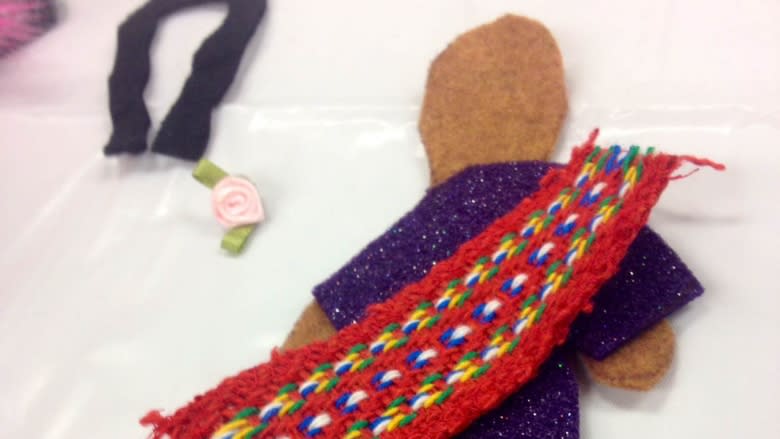100s of Faceless Dolls representing missing, murdered women disappear from Native Women's Association
Hundreds of faceless dolls created as a part of a project to commemorate murdered and missing Indigenous women have vanished from the offices of the Native Women's Association of Canada.
No one seems to know what happened to about 482 dolls, each decorated individually by the families of those missing and the murdered as part of the Faceless Dolls Project. The dolls were mean to represent 582 Indigenous women who were the "faceless victims of crime," says a description of the project on the association's website.
What happened to the dolls remains a mystery, said Lynne Groulx, executive director of the Native Women's Association of Canada, located in Ottawa.
"With regard to theories, they would only be rumours, as we were not able to obtain hard evidence to any theory. It was, and still remains, a mystery," said Groulx, in a statement sent to CBC News Thursday.
Word of the dolls' disappearance shocked Dorothy Campbell, 67.
Campbell decorated one of the dolls to commemorate both her aunt Rachel Manichoose, who was murdered in 1970, and her cousin Cecile Manichoose, who was killed in the late 1980s. Rachel Manichoose's killer, a non-Indigenous partner, was given a six-month sentence for the murder committed with a gun blast to the head. Cecile Manichoose's homicide remains unsolved, Campbell said.
"How could they lose something like that?" said Campbell, a residential school survivor. "Those were people we made. I don't know how they lost them. How can you lose something like that?
"That does mean something. It's just like, it's all over again. Like they were trash then, they are trash today. That is what I felt: not again, not all over again."
Campbell's daughter, artist Gloria Larocque, was asked by NWAC to develop the project in 2012. The concept was an outgrowth of her work on the Aboriginal Angel Doll Project, which featured 100 faceless dolls.
Larocque said the loss of the dolls is a "huge blow."
"I hope this isn't symbolic of the bigger picture, and yet, it has to be, because there are so many Indigenous women being misplaced and lost and what does NWAC do?" she said.
"It's sad for the families who put their thoughts and love into the dolls with the smallest measure of hope their artwork would create awareness of the beauty and resilience of their family member.… It is disappointing that, at the end of it, that the doll project becomes purely symbolic of what is happening with Indigenous women still."
When the dolls disappeared is also a mystery.
They were last displayed in Winnipeg during the national roundtable on murdered and missing Indigenous women held in late February 2016.
Groulx said in the statement that "nine or 10" panels of dolls could not be found. The organization still has about 100 dolls from a total of 582.
"The dolls are considered sacred, and we are very upset by this loss," she said. "We do feel the powerful spirits that were involved in their creation and their significance to the families of missing and murdered women and girls."
Groulx said she tried to find out what happened to the dolls shortly after she started work as executive director in November 2016.
"When I inquired as to where they were, I received conflicting stories that they had either not been returned or that they had returned and were stored in boxes and then disappeared. No one had any additional information," she said.
"In asking around, I was unable to get any further verification as to their whereabouts. There was a skeleton staff at the organization at that time and no one actually saw or knew what had happened."
Dawn Harvard was president of NWAC at the time of the dolls' disappearance. Harvard, who now heads the Ontario Native Women's Association, said she has no answers.
"That is the tragedy of it — I don't know," Harvard said in a brief interview Thursday. "I honestly can't tell you. I know nothing."
Personalized dolls
The Faceless Dolls Project was launched in March 2012 and was taken across the country to gather artistic input from the families of missing and murdered women.
Larocque constructed the body and dress for the dolls, which were then decorated by family members.
Larocque said she remembers family members using certain colours that were favourites of their lost daughters, sisters or mothers. Sometimes family members put feathers in the dolls' hair or fashioned tiny regalia outfits.
"Each one is decorated in a very different way," said Larocque.
Campbell said she remembers adorning her doll with the colour silver-grey during a gathering in Edmonton. Everyone was "very emotional" while decorating the dolls, she said.
"I tried to make them the age that they would be. I put silver-grey hair," said Campbell.
Groulx said a decision was made by her predecessor not to inform the families about the loss, partly because they lacked information and also over fears the news could cause more trauma.
"We are still hopeful, although hope is fading, that somehow they will be returned," said Groulx. "If anyone has any information or leads, we would ask them to contact us so that we can get to the bottom of it."
While saddened by the loss of the dolls, Larocque said the disappearance provides an opportunity for the dialogue that began with the project to evolve.
"Instead of faceless dolls, we can make dolls with faces and reclaim our family members, our sisters," she said.
"Even though the faceless aspect is very powerful and very political, why don't we try something else and put some faces and focus on the reclaiming?"
Family members and friends who would like support are encouraged to utilize one of the resources found here.



